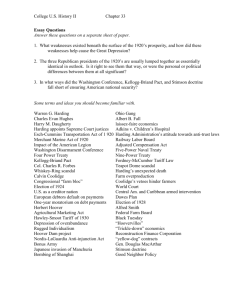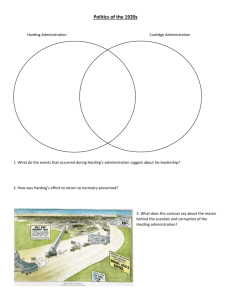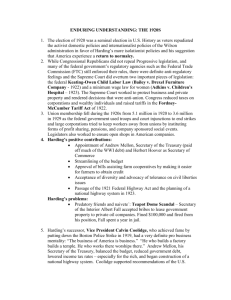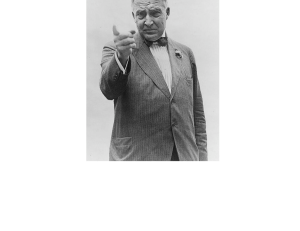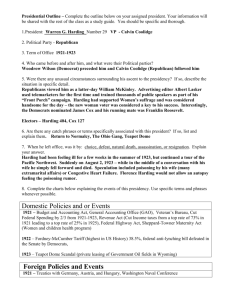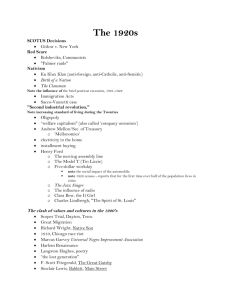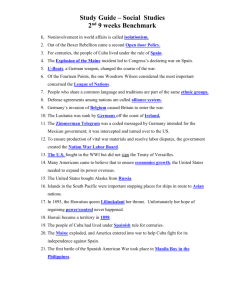Chapter 32, part-1 - apush
advertisement
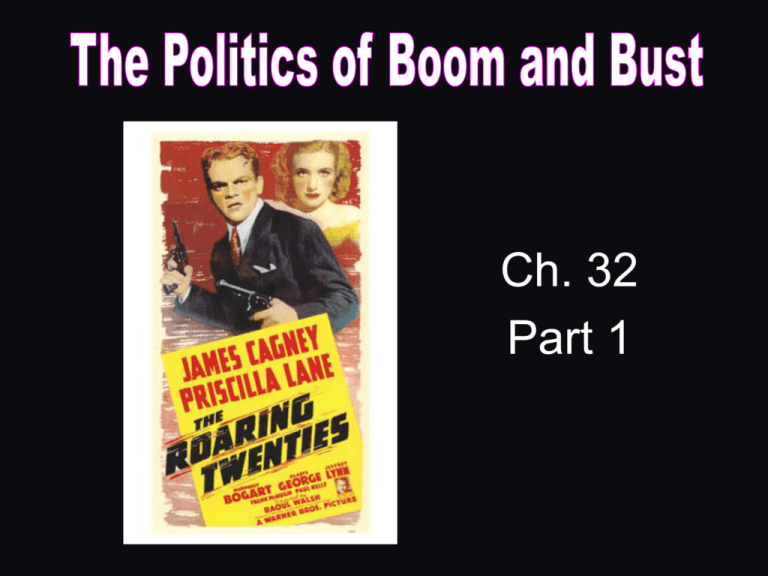
Ch. 32 Part 1 The Republican “Old Guard” Returns • Newly elected President Warren G. Harding was tall, handsome, and popular, but he had a mediocre mind and he did not like to hurt people’s feelings. – Nor could he detect the corruption within his adminstration. • His cabinet did have some good officials, though, such as Secretary of State Charles Evans Hughes, who was masterful, imperious, incisive, and brilliant, Secretary of Commerce Herbert Hoover, and Secretary of the Treasury Andrew W. Mellon. • However, people like Senator Albert B. Fall of New Mexico, a scheming anticonservationist, became secretary of the interior, and Harry M. Daugherty took over the reigns as attorney general. • Riddled with criminals, Fall and Daugherty became the worst of Harding’s scandalous cabinet members. GOP Reaction at the Throttle • A good man but a weak one, Harding was the perfect front for old-fashioned politicians to set up for the nation a McKinley-style old conservative order. – It hoped to further laissez-faire capitalism, and one of the examples of this was to encourage this through the Supreme Court, where Harding appointed four of the nine justices, including William H. Taft, former president of the United States. • Examples of a more “old-school” Court include the fact that in the early 1920s, the Supreme Court killed a federal childlabor law. • In the Supreme Court cases of Muller and Adkins, the issues centered on the question of whether women merited special legal and social treatment. • In the case of Adkins v. Children’s Hospital, the court reversed its ruling in the Muller v. Oregon case by invalidating a minimum wage law for women. • Republican economic policies under Harding hoped to encourage the government to actively assist businesses along the path to profits. • Under Harding, corporations could expand again, and antitrust laws were not as enforced or downright ignored. • For example, men sympathetic to railroads headed the Interstate Commerce Commission. The Aftermath of the War Wartime government controls disappeared (i.e. the dismantling of the War Industries Board) and Washington returned control of railroads to private hands by the Esch-Cummins Transportation Act of 1920. The Merchant Marine Act of 1920 authorized the Shipping Board, which controlled about 1,500 vessels, to get rid of a lot of ships at bargain prices, thus reducing the size of the navy. Labor lost much of its power, as a strike was ruthlessly broken in 1919, and the Railway Labor Board ordered a wage cut of 12% in 1922. Labor membership shrank by 30% from 1920 to 1930. Needy veterans were among the few non-business groups to reap lasting gains from the war. In 1921, the Veterans’ Bureau was created to operate hospitals and provide vocational rehabilitation for the disabled. – Many veterans wanted the monetary compensation promised to them for their services in the war. – The Adjusted Compensation Act gave every former soldier a paid-up insurance policy due in twenty years. America Seeks Benefits Without Burdens Since America had never ratified the Treaty of Versailles, it was still technically at war with Germany, so in July of 1921, it passed a simple joint resolution ending the war. Because of Warren G. Harding’s policy of isolationism, the U.S. did not cooperate much with the League of Nations, but eventually, “unofficial observers” did participate in conferences. The lack of real participation though from the U.S. proved to doom the League. One exception to President Harding’s isolationist policy was in the Middle East where Secretary Hughes secured for American oil companies the right to share in the exploitation of the oil riches there (gee, wonder why they don’t like us…?) Disarmament was another problem for Harding since he still had to watch the actions of other world powers for any possible hostile activities. – America also went on a “ship-scrapping” bonanza. – The Washington “Disarmament” Conference of 1921-22 resulted in a plan that kept a 5:5:3 ratio of battleships that could be held by the U.S., Britain, and Japan (in that order). This surprised many delegates at the conference, not to mention the brand new Soviet Union, which was not recognized by the U.S., was not invited, and did not attend. – The Five-Power Naval Treaty of 1922 embodied Hughes’s ideas on ship ratios, but only after the Japanese received compensation. – A Four-Power Treaty, which bound Britain, Japan, France, and the U.S. to preserve the status quo in the Pacific, replaced the 20year-old Anglo-Japanese Alliance. – The Nine-Power Treaty of 1922 kept the open door open in China. – However, despite all this apparent action, there were no limits placed on “small” ships, and Congress only approved the Four-Power Treaty on the condition that the U.S. not be bound to it, thus effectively rendering that treaty useless. • Frank B. Kellogg, Calvin Coolidge’s Secretary of State, won the Nobel Peace Prize for his role in the Kellogg-Briand Pact (Pact of Paris), which said that all nations that signed would no longer use war as a solution to international rivalries. • Unfortunately, it was ultimately meaningless, nothing but a “handshake” agreement.
